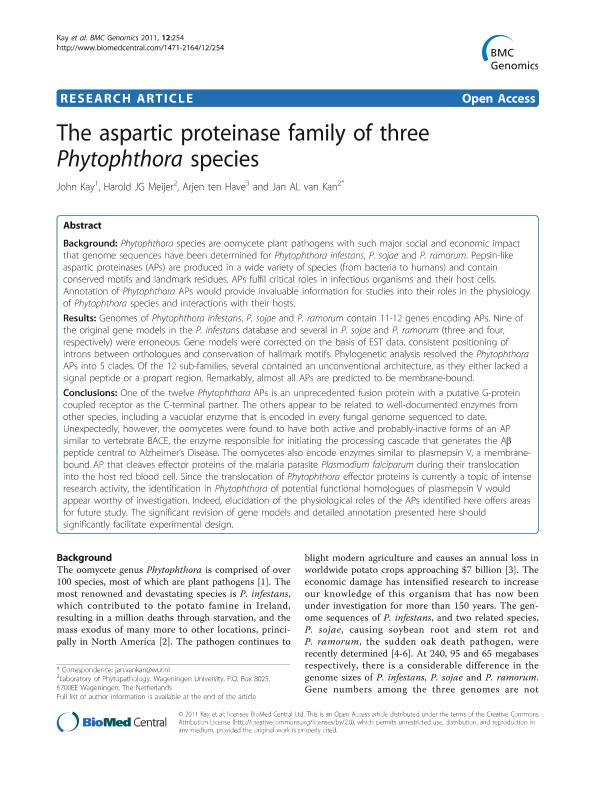Mostrar el registro sencillo del ítem
dc.contributor.author
Kay, John
dc.contributor.author
Meijer, Harold J. G.
dc.contributor.author
Ten Have, Arjen

dc.contributor.author
van Kan, Jan A. L.
dc.date.available
2017-02-22T14:14:49Z
dc.date.issued
2011-05
dc.identifier.citation
Kay, John; Meijer, Harold J. G.; Ten Have, Arjen; van Kan, Jan A. L.; The aspartic proteinase family of three Phytophthora species; BioMed Central; Bmc Genomics; 12; 5-2011; 254-268
dc.identifier.issn
1471-2164
dc.identifier.uri
http://hdl.handle.net/11336/13291
dc.description.abstract
Background: Phytophthora species are oomycete plant pathogens with such major social and economic impact that genome sequences have been determined for Phytophthora infestans, P. sojae and P. ramorum. Pepsin-like aspartic proteinases (APs) are produced in a wide variety of species (from bacteria to humans) and contain conserved motifs and landmark residues. APs fulfil critical roles in infectious organisms and their host cells. Annotation of Phytophthora APs would provide invaluable information for studies into their roles in the physiology of Phytophthora species and interactions with their hosts. Results: Genomes of Phytophthora infestans, P. sojae and P. ramorum contain 11-12 genes encoding APs. Nine of the original gene models in the P. infestans database and several in P. sojae and P. ramorum (three and four, respectively) were erroneous. Gene models were corrected on the basis of EST data, consistent positioning of introns between orthologues and conservation of hallmark motifs. Phylogenetic analysis resolved the Phytophthora APs into 5 clades. Of the 12 sub-families, several contained an unconventional architecture, as they either lacked a signal peptide or a propart region. Remarkably, almost all APs are predicted to be membrane-bound. Conclusions: One of the twelve Phytophthora APs is an unprecedented fusion protein with a putative G-protein coupled receptor as the C-terminal partner. The others appear to be related to well-documented enzymes from other species, including a vacuolar enzyme that is encoded in every fungal genome sequenced to date. Unexpectedly, however, the oomycetes were found to have both active and probably-inactive forms of an AP similar to vertebrate BACE, the enzyme responsible for initiating the processing cascade that generates the Aβ peptide central to Alzheimer's Disease. The oomycetes also encode enzymes similar to plasmepsin V, a membrane-bound AP that cleaves effector proteins of the malaria parasite Plasmodium falciparum during their translocation into the host red blood cell. Since the translocation of Phytophthora effector proteins is currently a topic of intense research activity, the identification in Phytophthora of potential functional homologues of plasmepsin V would appear worthy of investigation. Indeed, elucidation of the physiological roles of the APs identified here offers areas for future study. The significant revision of gene models and detailed annotation presented here should significantly facilitate experimental design.
dc.format
application/pdf
dc.language.iso
eng
dc.publisher
BioMed Central

dc.rights
info:eu-repo/semantics/openAccess
dc.rights.uri
https://creativecommons.org/licenses/by/2.5/ar/
dc.subject
Aspartic Protease
dc.subject
Late Blight
dc.subject
Phytophthora Species
dc.subject.classification
Biología

dc.subject.classification
Ciencias Biológicas

dc.subject.classification
CIENCIAS NATURALES Y EXACTAS

dc.title
The aspartic proteinase family of three Phytophthora species
dc.type
info:eu-repo/semantics/article
dc.type
info:ar-repo/semantics/artículo
dc.type
info:eu-repo/semantics/publishedVersion
dc.date.updated
2017-02-21T14:38:16Z
dc.journal.volume
12
dc.journal.pagination
254-268
dc.journal.pais
Reino Unido

dc.journal.ciudad
Londres
dc.description.fil
Fil: Kay, John. Cardiff University; Reino Unido
dc.description.fil
Fil: Meijer, Harold J. G.. Wageningen University; Reino Unido
dc.description.fil
Fil: Ten Have, Arjen. Consejo Nacional de Investigaciones Científicas y Técnicas. Centro Científico Tecnológico Mar del Plata. Instituto de Investigaciones Biológicas; Argentina. Universidad Nacional de Mar del Plata. Facultad de Ciencias Exactas y Naturales; Argentina
dc.description.fil
Fil: van Kan, Jan A. L.. Wageningen University; Reino Unido
dc.journal.title
Bmc Genomics

dc.relation.alternativeid
info:eu-repo/semantics/altIdentifier/url/http://bmcgenomics.biomedcentral.com/articles/10.1186/1471-2164-12-254
dc.relation.alternativeid
info:eu-repo/semantics/altIdentifier/doi/http://dx.doi.org/10.1186/1471-2164-12-254
Archivos asociados
